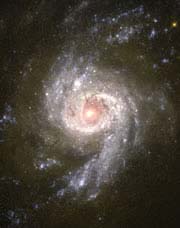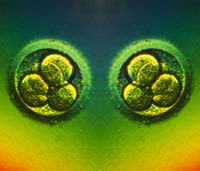Latest News

Global goal frenzy
It’s official: English football teams score fewer goals.
Soccer teams worldwide are scoring more goals than they ought to be, whereas English teams seem to follow statistical expectations. The news may delight fans outside England, but it is puzzling the physicists who have found that the chance of a high-scoring game is significantly greater than it may first appear 1 .
John Greenhough and colleagues at Warwick University in Coventry, England, analysed the s

Distant starlight reveals alien atmosphere
Hubble spots atmosphere on planet 150 light years away.
Astronomers have glimpsed the atmosphere of a planet in a solar system other than our own for the first time. The feat is a first step towards detecting planets capable of supporting life elsewhere in the Universe.
David Charbonneau, of the California Institute of Technology, Pasadena, and colleagues, pointed the Hubble space telescope at the planet, which lies 150 light years away in the constellation Pegasus. Of the 7

Human clone not miracle cure
Rewiring the egg: mechanism remains murky.
From a scientific viewpoint, the cloning of human embryos may be more of a step than a leap, say sceptics. If the signals that turn adult cells into embryonic ones can be found, the creation of cloned embryos for tissue repair may become redundant.
Researchers at Advanced Cell Technology (ACT) in Worcester, Massachusetts, now report that they have created cloned human embryos. They aimed to make blastocysts, hollow balls of cells fr

Land Size Limits Body Size of Biggest Animals
The size and types of the largest local land animals vary greatly from place to place, prompting scientists to question what controls the success of animals of certain sizes over others. Now a report published in the current issue of the Proceedings of the National Academy of Sciences shows that the size of a landmass limits the maximal body size of its top animal.
Gary Burness and Jared Diamond of the University of California School of Medicine, together with Timothy Flannery of the South

Researchers Isolate Genes for Mosquito’s Sense of Smell
New research is helping to unravel the machinery that allows a mosquito to sniff out its human quarry, which could lead to more and better ways of foiling the disease-spreading insects. A report published today in the online version of the Proceedings of the National Academy of Sciences describes four genes that appear to produce odor-sensing molecules in Africa’s Anopheles gambiae, a carrier of malaria, the number two killer in the developing world. Understanding how such genes operate could en

DNA repair could reduce sunburn
An immune system chemical may undo skin damage by sunlight.
A chemical involved in immune-system signalling may be able to reverse some types of skin damage caused by sunlight. It could reduce sunburn by activating DNA-repair mechanisms, a new study suggests, raising the possibility that the chemical might be used to prevent or treat skin cancer 1 .
High-energy ultraviolet light is thought to promote skin cancer by damaging the DNA within cells. Skin cancer,











